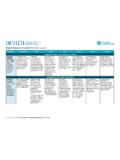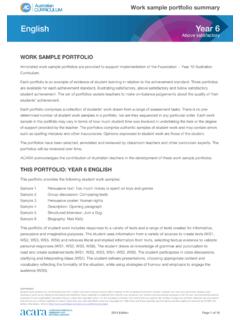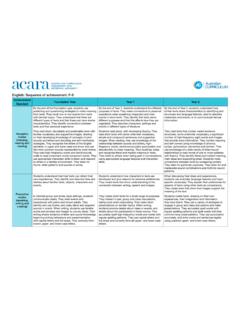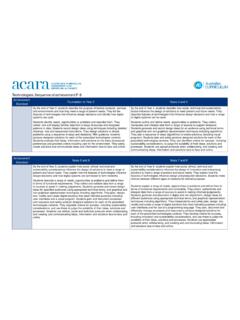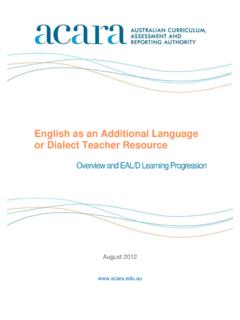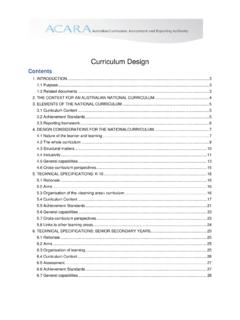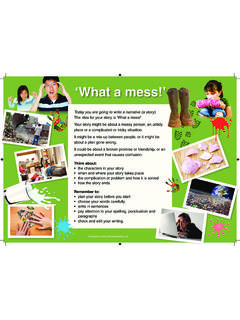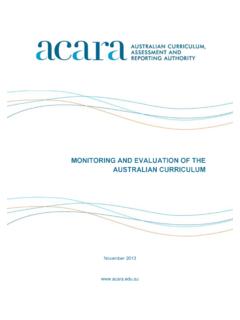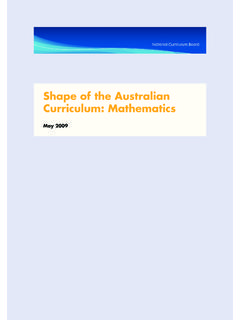Transcription of nglish Year 1 - ACARA
1 EnglishYear 1 Satisfactory2014 EditionPage 1 of 17 Work sample portfolio summaryWORK SAMPLE PORTFOLIOA nnotated work sample portfolios are provided to support implementation of the Foundation year 10 Australian portfolio is an example of evidence of student learning in relation to the achievement standard. Three portfolios are available for each achievement standard, illustrating satisfactory, above satisfactory and below satisfactory student achievement. The set of portfolios assists teachers to make on-balance judgements about the quality of their students portfolio comprises a collection of students work drawn from a range of assessment tasks. There is no pre-determined number of student work samples in a portfolio, nor are they sequenced in any particular order. Each work sample in the portfolio may vary in terms of how much student time was involved in undertaking the task or the degree of support provided by the teacher. The portfolios comprise authentic samples of student work and may contain errors such as spelling mistakes and other inaccuracies.
2 Opinions expressed in student work are those of the portfolios have been selected, annotated and reviewed by classroom teachers and other curriculum experts. The portfolios will be reviewed over time. ACARA acknowledges the contribution of Australian teachers in the development of these work sample portfolios. THIS PORTFOLIO: year 1 ENGLISHThis portfolio provides the following student work samples: Sample 1 Text response: Illustrations Sample 2 Information text: Koalas Sample 3 Reading aloud: The Football Sample 4 Personal connection to text: Reflecting on learning Sample 5 Reading aloud and responding to questions: Queenie the Bantam Sample 6 Reading response: Dunbi the Owl Sample 7 Descriptive text: Wanted poster Sample 8 Story map: TiddalikThis portfolio of student work includes responses to a variety of texts and the development of a range of written and oral texts (WS1, WS2, WS4, WS6, WS7, WS8). The student s work shows evidence of recalled information (WS2, WS4, WS8) with characters and events created for imaginative writing (WS1, WS7).
3 The student uses familiar and new vocabulary including modelled words and groups/phrases (WS1, WS2, WS4, WS5, WS6, WS7, WS8) and a range of sentence structures (WS1, WS2, WS4, WS5, WS6, WS7). The student demonstrates attention to spelling and punctuation and, with teacher assistance, the ability to make editing changes and publish final drafts (WS1, WS2, WS4, WS6, WS7). The student is confident when reading aloud to peers and familiar adults (WS3, WS5) and when making presentations (WS8).COPYRIGHTS tudent work samples are not licensed under the creative commons license used for other material on the Australian Curriculum website. Instead, you may view, download, display, print, reproduce (such as by making photocopies) and distribute these materials in unaltered form only for your personal, non-commercial educational purposes or for the non-commercial educational purposes of your organisation, provided that you retain this copyright notice. For the avoidance of doubt, this means that you cannot edit, modify or adapt any of these materials and you cannot sub-license any of these materials to others.
4 Apart from any uses permitted under the Copyright Act 1968 (Cth), and those explicitly granted above, all other rights are reserved by ACARA . For further information, refer to ( ).EnglishYear 1 SatisfactoryWork sample 12014 EditionPage 2 of 17 Text response: IllustrationsYear 1 English achievement standardThe parts of the achievement standard targeted in the assessment task are modes (listening, reading and viewing)By the end of year 1, students understand the different purposes of texts. They make connections to personal experience when explaining characters and main events in short texts. They identify the language features, images and vocabulary used to describe characters and read aloud, with developing fluency and intonation, short texts with some unfamiliar vocabulary, simple and compound sentences and supportive images. When reading, they use knowledge of sounds and letters, high frequency words, sentence boundary punctuation and directionality to make meaning.
5 They recall key ideas and recognise literal and implied meaning in texts. They listen to others when taking part in conversations, using appropriate language features. They listen for and reproduce letter patterns and letter modes (speaking, writing and creating)Students understand how characters in texts are developed and give reasons for personal preferences. They create texts that show understanding of the connection between writing, speech and create short texts for a small range of purposes. They interact in pair, group and class discussions, taking turns when responding. They make short presentations of a few connected sentences on familiar and learned topics. When writing, students provide details about ideas or events. They accurately spell words with regular spelling patterns and use capital letters and full stops. They correctly form all upper- and lower-case of taskStudents studied the texts of Eric Carle, with a focus on his illustrations, and viewed Eric Carle s website to watch how he created his illustrations.
6 They experimented with creating their own illustrations using a similar technique. Students were asked to respond to written questions about their artwork choices. The questions were read and discussed beforehand, and students completed a first draft before writing their answers on the sample 1 EnglishYear 1 Satisfactory2014 EditionPage 3 of 17 CopyrightStudent work samples are not licensed under the creative commons license used for other material on the Australian Curriculum website. Instead, a more restrictive licence applies. For more information, please see the first page of this set of work samples and the copyright notice on the Australian Curriculum website ( ).AnnotationsCreates an image to depict a character showing understanding of an illustrator s connections to personal experience when explaining preference for a a short informative text for a specific full stops and capital letters for sentence boundary a series of accurate sentences to present legibly using correctly formed upper- and lower-case words with regular spelling patterns accurately, for example, green , dark , make.
7 Text response: IllustrationsEnglishYear 1 Satisfactory2014 EditionPage 4 of 17 Information text: KoalasYear 1 English achievement standardThe parts of the achievement standard targeted in the assessment task are modes (listening, reading and viewing)By the end of year 1, students understand the different purposes of texts. They make connections to personal experience when explaining characters and main events in short texts. They identify the language features, images and vocabulary used to describe characters and read aloud, with developing fluency and intonation, short texts with some unfamiliar vocabulary, simple and compound sentences and supportive images. When reading, they use knowledge of sounds and letters, high frequency words, sentence boundary punctuation and directionality to make meaning. They recall key ideas and recognise literal and implied meaning in texts. They listen to others when taking part in conversations, using appropriate language features.
8 They listen for and reproduce letter patterns and letter modes (speaking, writing and creating)Students understand how characters in texts are developed and give reasons for personal preferences. They create texts that show understanding of the connection between writing, speech and create short texts for a small range of purposes. They interact in pair, group and class discussions, taking turns when responding. They make short presentations of a few connected sentences on familiar and learned topics. When writing, students provide details about ideas or events. They accurately spell words with regular spelling patterns and use capital letters and full stops. They correctly form all upper- and lower-case of taskStudents read and viewed a collection of informative texts about koalas. In pairs they read and listed facts about koalas. Students compared koalas in informative and imaginative texts. Students were asked to write an informative text about koalas and to include a labelled sample 2 EnglishYear 1 Satisfactory2014 EditionPage 5 of 17 CopyrightStudent work samples are not licensed under the creative commons license used for other material on the Australian Curriculum website.
9 Instead, a more restrictive licence applies. For more information, please see the first page of this set of work samples and the copyright notice on the Australian Curriculum website ( ).AnnotationsCreates a short informative text to present researched information about a some technical vocabulary, for example, pouch , gum leaves , marsupial .Uses simple and compound sentences to record details and connect information. Uses capital letters and full stops for sentence boundary legibly using unjoined upper- and lower-case familiar words correctly and uses sound and letter knowledge to attempt unfamiliar words, for example, wecs [weeks], climing [climbing].Uses a labelled diagram to expand information in the written text. Information text: KoalasWork sample 2 EnglishYear 1 Satisfactory2014 EditionPage 6 of 17 Reading aloud: The FootballYear 1 English achievement standardThe parts of the achievement standard targeted in the assessment task are modes (listening, reading and viewing)By the end of year 1, students understand the different purposes of texts.
10 They make connections to personal experience when explaining characters and main events in short texts. They identify the language features, images and vocabulary used to describe characters and read aloud, with developing fluency and intonation, short texts with some unfamiliar vocabulary, simple and compound sentences and supportive images. When reading, they use knowledge of sounds and letters, high frequency words, sentence boundary punctuation and directionality to make meaning. They recall key ideas and recognise literal and implied meaning in texts. They listen to others when taking part in conversations, using appropriate language features. They listen for and reproduce letter patterns and letter modes (speaking, writing and creating)Students understand how characters in texts are developed and give reasons for personal preferences. They create texts that show understanding of the connection between writing, speech and create short texts for a small range of purposes.
